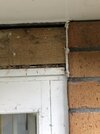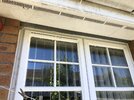The back of my house is effectively a single storey (house is built in to a hillside) and the wall is a block/brick cavity wall supporting a roof of interlocking (concrete?) tiles. It's a 1990's Wimpey construction. In this wall is a 1200mm wide window and a 1800mm french door, both have some form of cavity wall steel lintels.
The outer leaf of brick doesn't climb past the lintel, so the soffit board just rests on top of the lintel/bricks. Inside there is about 300mm of block above the lintel, before it meets the wall plate.
I'm planning to make the window much wider, around 2800mm, and make the doorway narrower to around 1000mm. I will need to build up the brick/block to make the doorway narrower, and that 'new' bit of wall will become the bearing for both the window and door lintels.
The resulting 'middle' bit of wall between the window and the door will be about 737mm wide, and provides a 150mm bearing on each side, one for the door and one for the window. How can I work out if this section of wall can support the loads?
The roof span is 9400 and 35 degrees.
If I assume worst case the block is 2.9N/mm2 then I calculate 737 x 100 x 2.9 = 213,730N but I have no idea if that is representative of its capacity to support lintels.
Any advice very much appreciated!
-phil

The outer leaf of brick doesn't climb past the lintel, so the soffit board just rests on top of the lintel/bricks. Inside there is about 300mm of block above the lintel, before it meets the wall plate.
I'm planning to make the window much wider, around 2800mm, and make the doorway narrower to around 1000mm. I will need to build up the brick/block to make the doorway narrower, and that 'new' bit of wall will become the bearing for both the window and door lintels.
The resulting 'middle' bit of wall between the window and the door will be about 737mm wide, and provides a 150mm bearing on each side, one for the door and one for the window. How can I work out if this section of wall can support the loads?
The roof span is 9400 and 35 degrees.
If I assume worst case the block is 2.9N/mm2 then I calculate 737 x 100 x 2.9 = 213,730N but I have no idea if that is representative of its capacity to support lintels.
Any advice very much appreciated!
-phil






